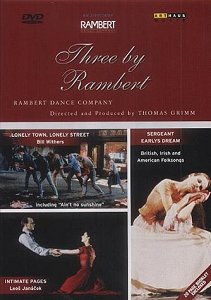This diverse and enjoyable DVD-V should be of interest
not only to experienced ballet lovers who will already be familiar with
the work of The Rambert Dance Company, but also to those in the early
stages of exploring ballet.
It consists of three varied pieces each one quite different
from its companions both in terms of the music and the style of dance.
The works concerned are:
Intimate Pages danced to the
music of Janáček’s second string quartet, and choreographed
by Christopher Bruce.
Lonely Town, Lonely Street, performed to
the music and vocals of Bill Withers with choreography by Robert
North.
Sergeant Early’s Dream where, as in the
Janacek, the choreographer is Christopher Bruce. This work is set
to a number of British, American, and Irish folksongs played and
sung in what I assume to be a traditional style by a group of seven
musicians.
The copyright of this disc is dated 1985, but the sound
and the picture quality of all the works was totally acceptable played
through a Toshiba 36 inch wide-screen television and Chord Electronics/B&W
N802 sound system.
For me normally the principal attraction of a ballet
is inspired by a liking for the music. In this case it was Intimate
Pages, the appeal of which lay in the
Janáček second string quartet played by the eponymously named Janáček
Quartet. This is a favourite work of mine which I have enjoyed hearing
them perform live, although I have always understood the title
attributed to the piece to be "Intimate Letters".
To my eyes the choreography, sets, and costumes all
harmonised well with my expectations. The costumes are elegant, and
the dance movements exemplified what I was hoping for in a modern interpretation
of relatively modern music whose characterful and at times deeply lyrical
sonorities still have a freshness and intensity after more than seventy
years.
Six dancers perform with fluidity and grace to most
of their movements, apart from some occasional ugly positions of the
feet whose significance was lost on me.
Generally I felt that
the choreography matched the passion and unique harmonies of Janáček’s
music admirably. For me this was a musical experience in which the addition
of dance in no way detracted from the music, yet added an extra
dimension which I believe would bear repeated viewing. However, complementary
though the dancing was to the music, I will not abandon this work on
CD as I feel that the two formats offer alternative forms of gratification.
Lonely Town, Lonely Streets is something entirely
different from the Janáček. Here we
have a “Jazz Ballet” which comprises seven scenes each danced to a different
song, in a set depicting night- time in a run-down area of a North American
city. The action centres upon a lonely person trying to integrate into
this environment, and the eight
dancers involved convey the passion, energy, as well as the hostility
and threatening nature of such an urban environment. Although the music
provided by Bill Withers is far removed from Janáček, both it and
the dancing, which is strongly athletic without a hint of the
"classical", held my attention and provided a welcome broadening
of my view of what nowadays constitutes ballet. Certainly it is a piece
to which I would return.
The final work, Sergeant Early’s Dream proved
to be the real eye-opener, and for me the highlight of the disc. I’m
relatively unfamiliar with "folk music", although I have always
been drawn to the plaintive quality of some Gaelic music. Well plaintive
sounds there are, but as the piece contains no less than fifteen different
songs there is a very broad range of styles, moods, and emotions, and
the whole work proved to be a total delight not least for its sheer
sense of fun. Fun is not a response that my preconceptions had led me
to expect, neither was the ability of the nine dancers to convey, not
only by gestures but also by facial expressions, such a diverse range
of emotions. Their agility athleticism and strength I had taken for
granted, but their acting was a revelation, and I found myself enchanted
by the grace and versatility of their movements. The musicians too complemented
the dancing admirably. Friends to whom I have shown this piece have
without exception found it highly entertaining.
I believe that the entire disc makes an ideal, well
balanced introduction to the modern dance form (not a tutu in sight),
and will give pleasure to tyro and expert alike. Certainly it is one
which will be added to my collection.
David Dyer


